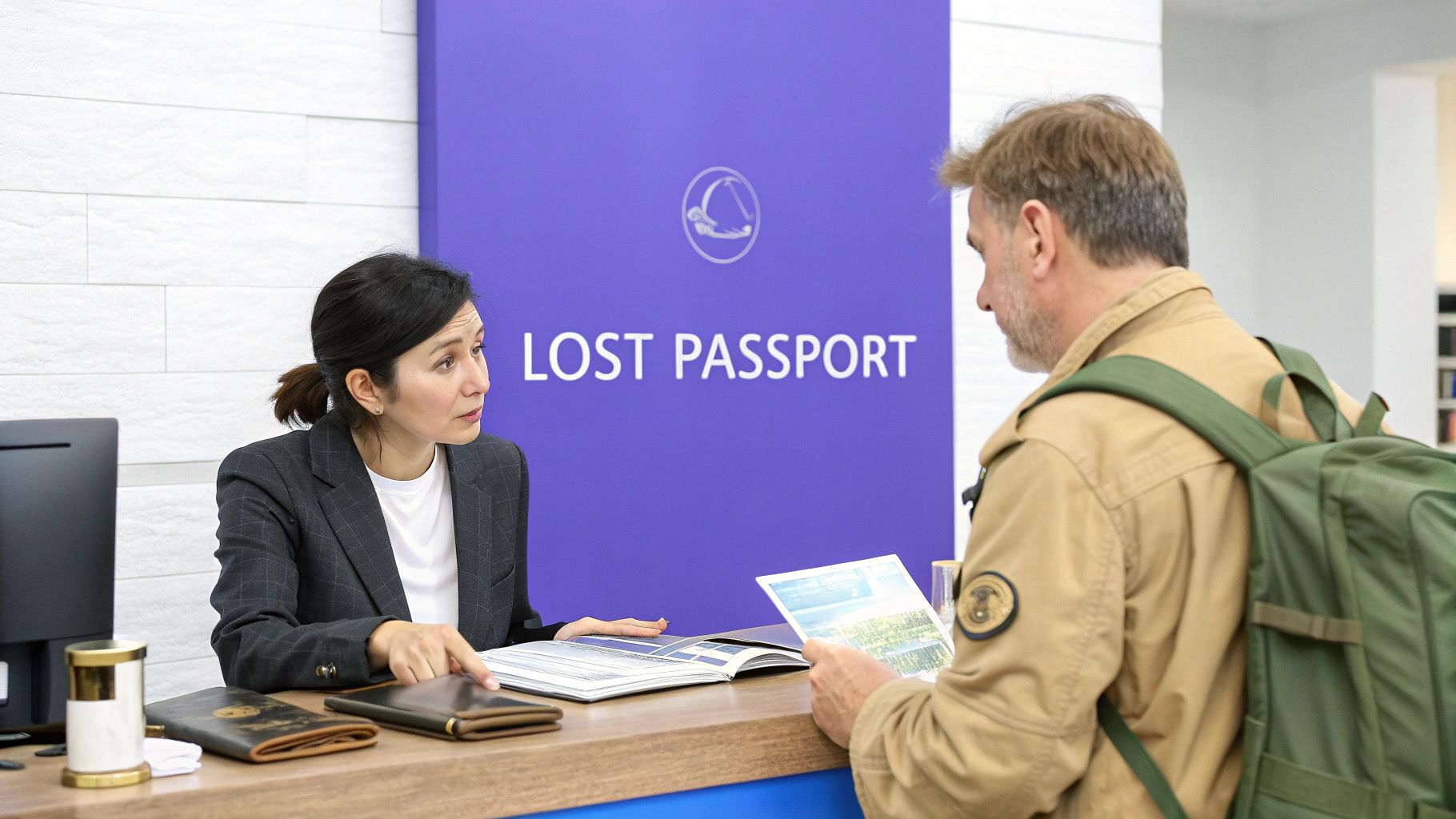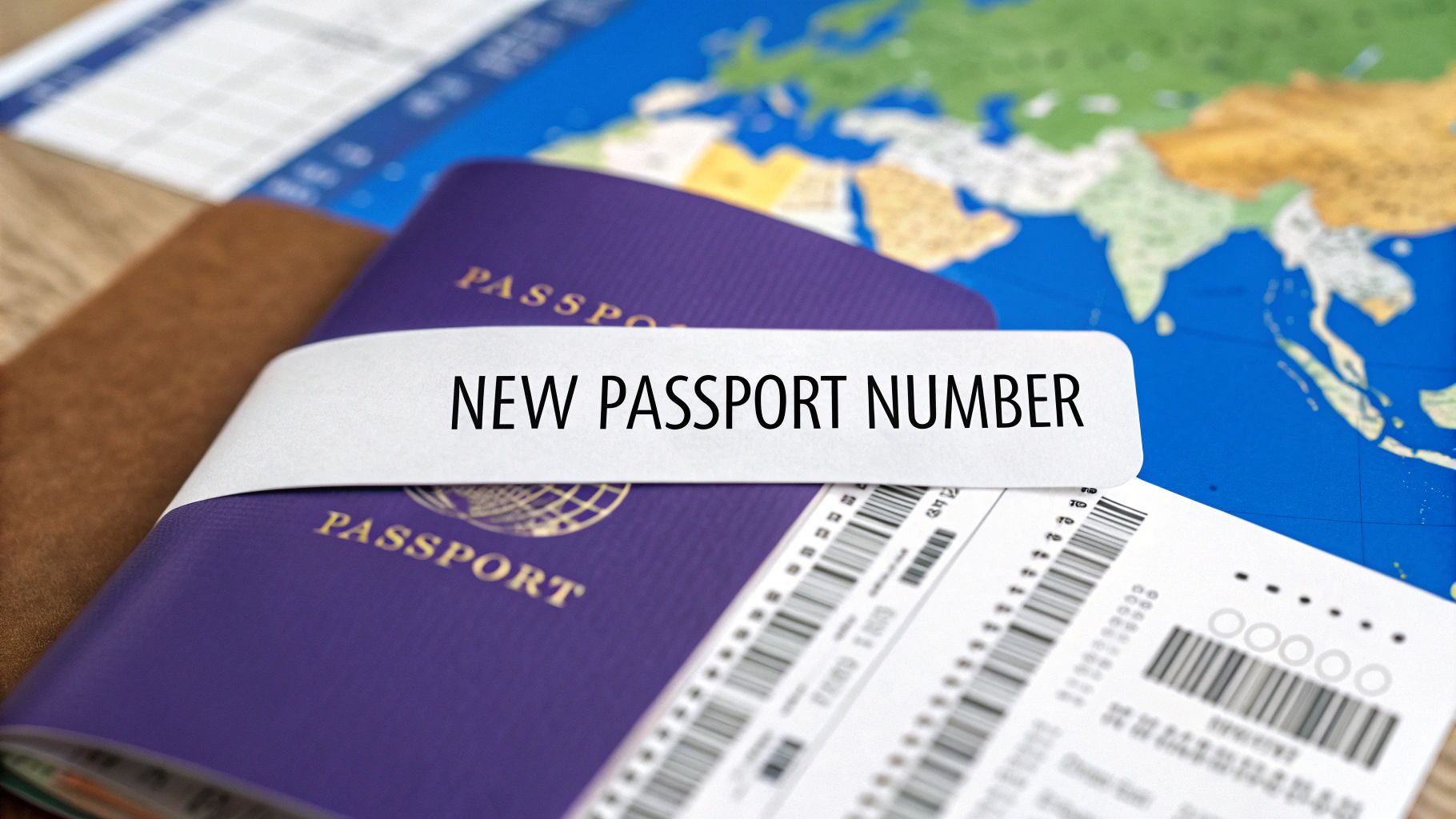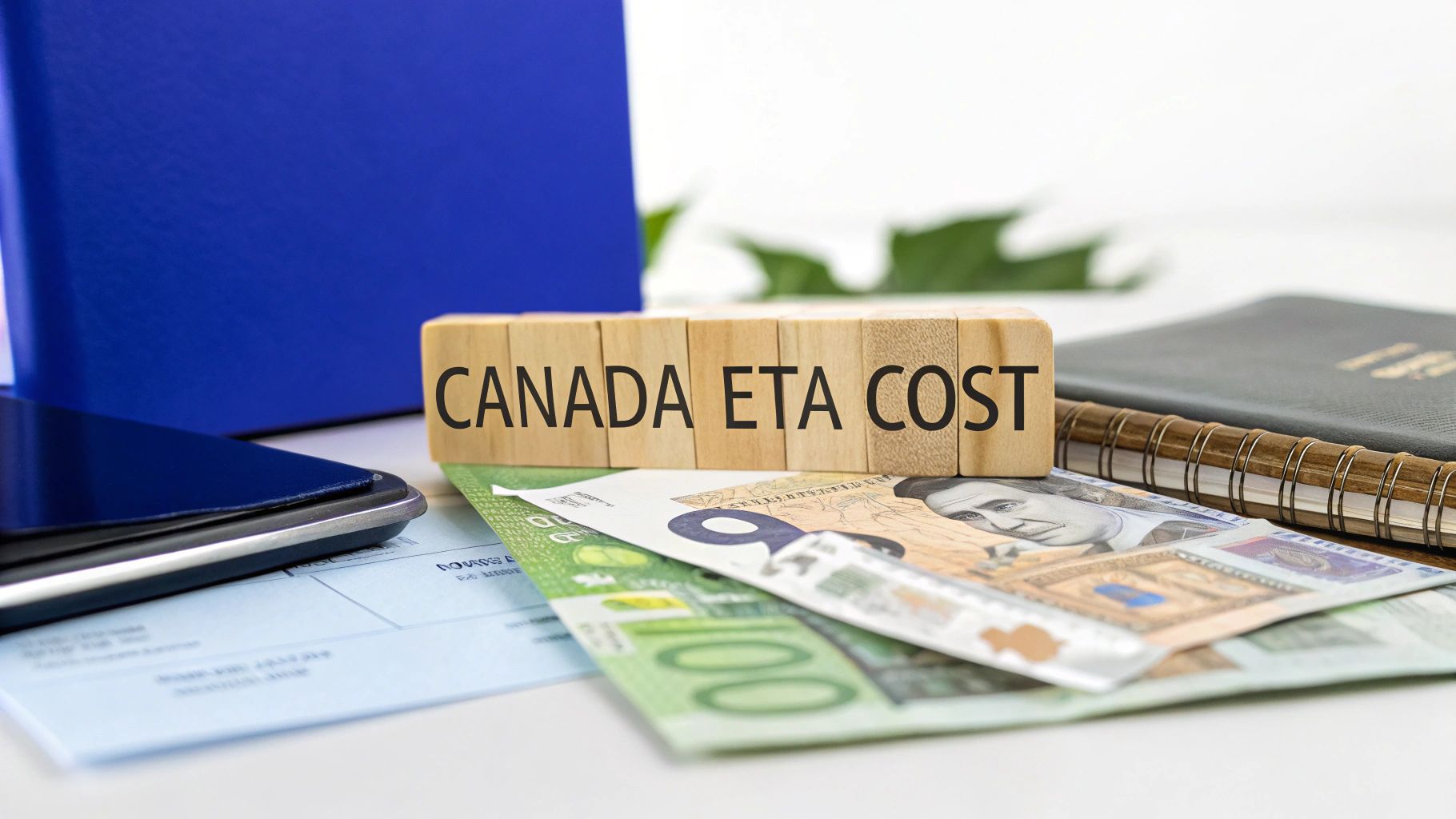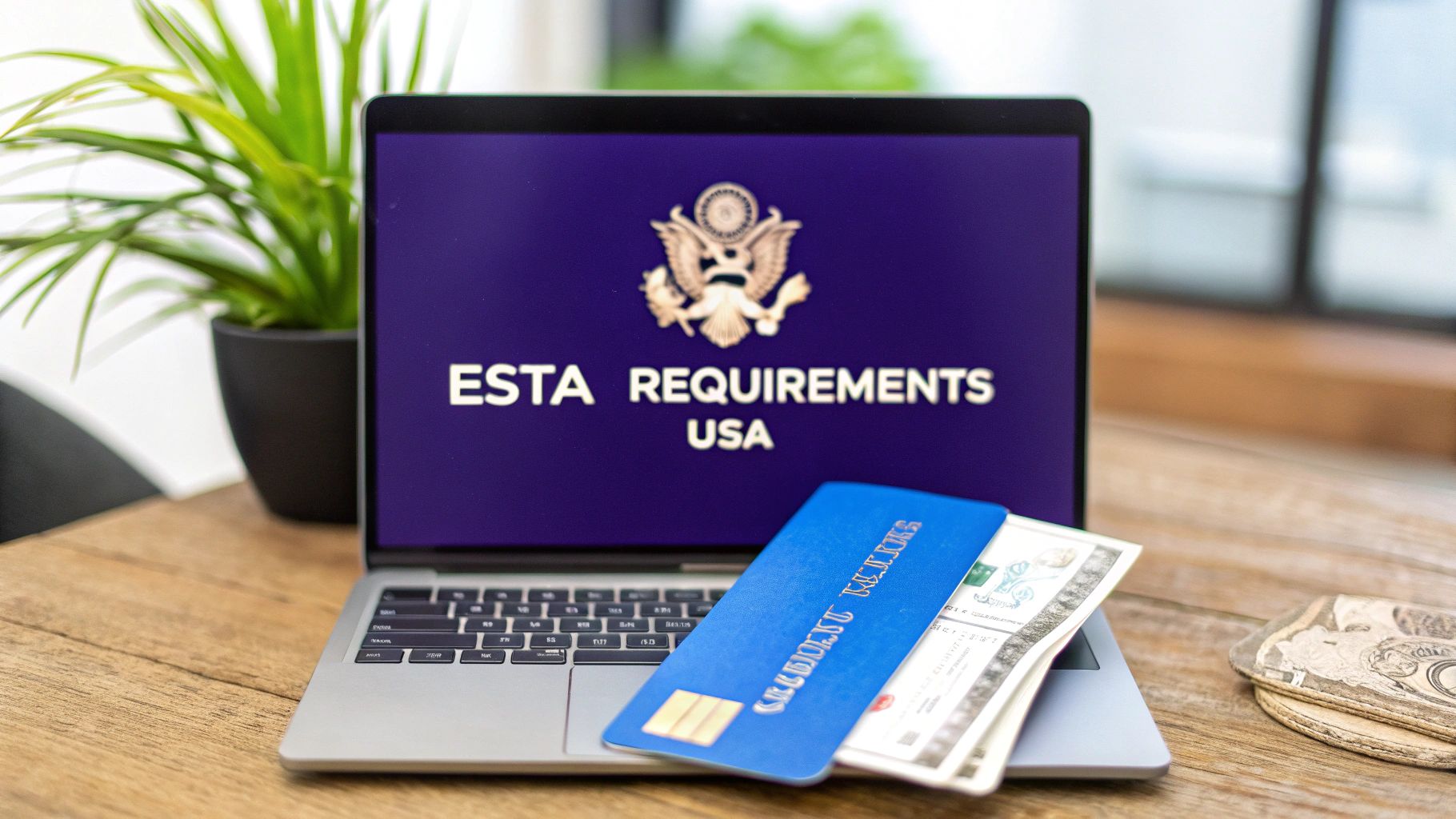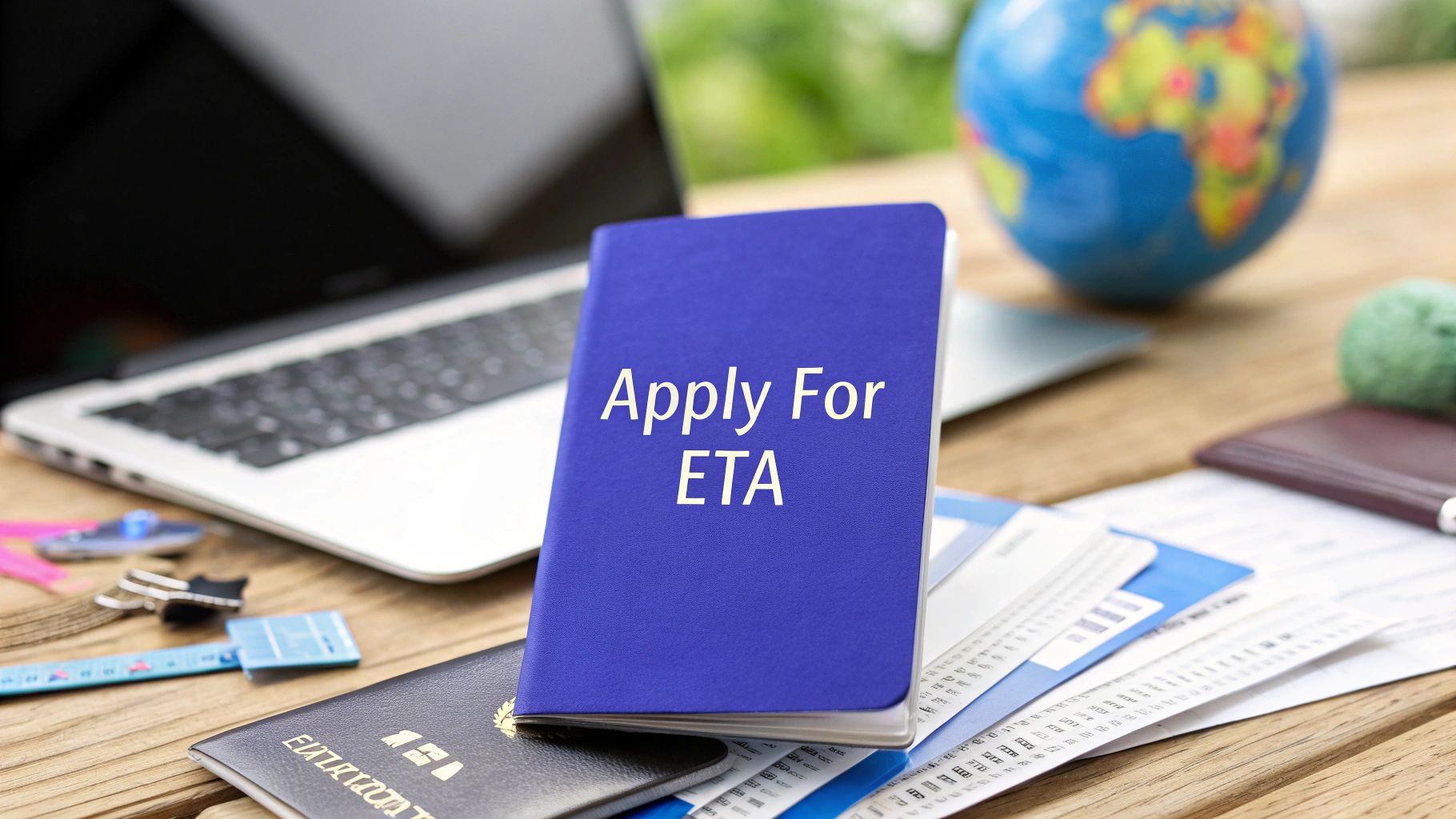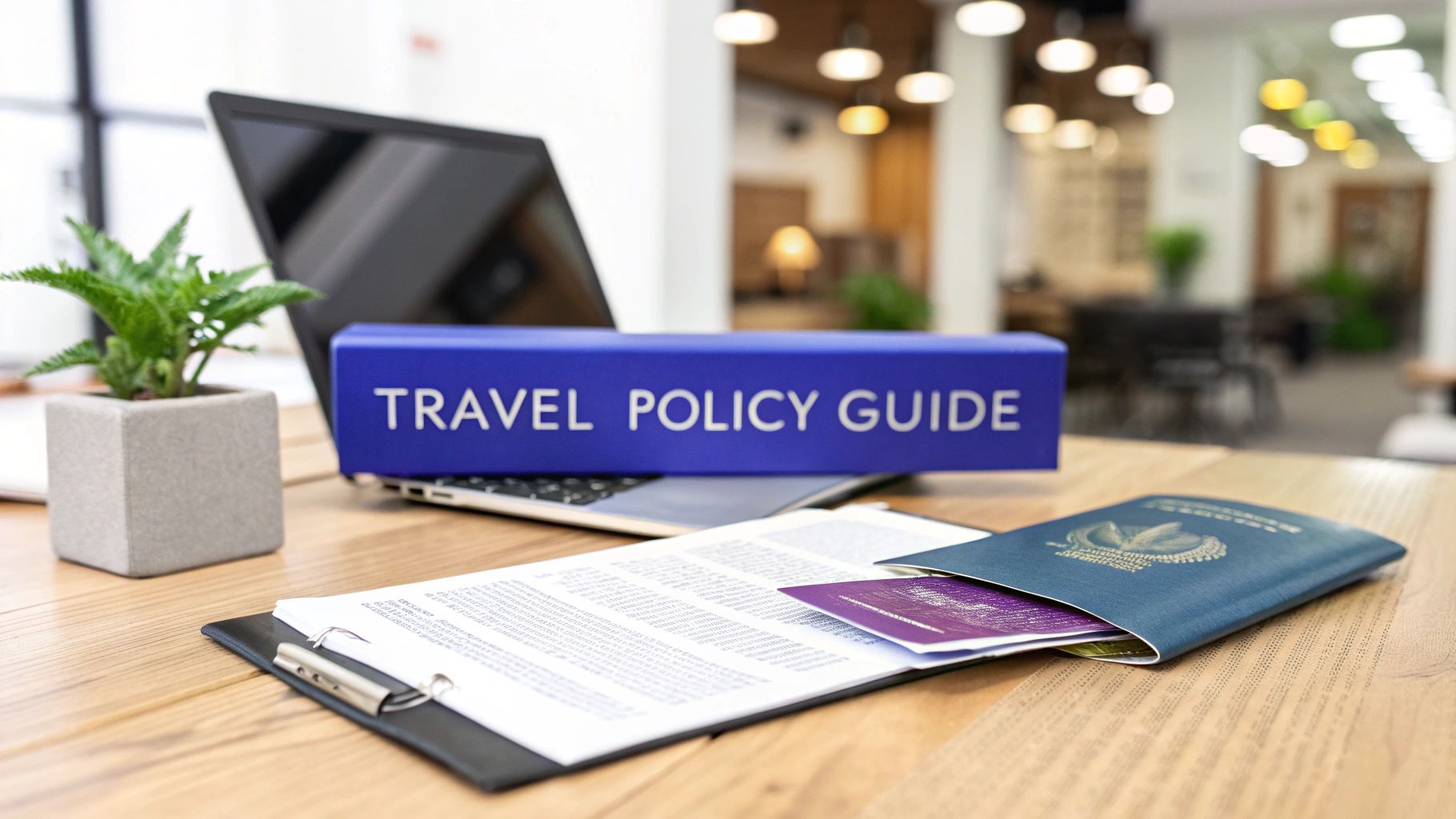
A Modern Corporate Travel Policy Template Guide
A solid corporate travel policy template is the roadmap that keeps your team safe, your budget in check, and your travel program running smoothly. But let’s be honest, staring at a blank page is the hardest part. The goal isn’t just to list rules, but to create a foundational document that prevents confusion from day one.
Building Your Policy's Foundation
It’s easy to get lost in the weeds when you’re building a policy from scratch. Instead of worrying about every minor detail right away, let's focus on the essential building blocks. A strong foundation ensures your policy is clear, fair, and actually supports your company's goals. This initial framework will guide every other decision you make.
A truly effective policy does more than just list do's and don'ts. It explains the why behind the guidelines, which helps create a culture of understanding and cooperation. It needs to clearly define who gets to travel, under what circumstances, and how those trips connect back to the business.
Before we dive into the nitty-gritty, here’s a quick overview of the essential sections you'll want to include. Think of these as the non-negotiables for any modern travel policy.
Core Components of a Modern Travel Policy
| Policy Section | Primary Goal | Example Focus |
|---|---|---|
| Purpose & Scope | Set clear expectations and define who the policy applies to. | Employee safety, cost management, and traveler experience. |
| Booking Procedures | Standardize how travel is booked to maintain control and visibility. | Preferred booking tools, approval workflows, and timelines. |
| Expense & Reimbursement | Outline what's covered and how employees get paid back. | Per diems, acceptable payment methods, and receipt submission. |
| Safety & Duty of Care | Prioritize traveler wellbeing and define emergency protocols. | Emergency contacts, risk management procedures, and health insurance. |
| Traveler Conduct | Set professional expectations for employees representing the company. | Personal travel extensions ("bleisure"), use of company assets. |
With this structure in mind, we can start building out each component, beginning with the most fundamental one: the purpose.
Defining the Purpose and Scope
Every good policy kicks off with a clear purpose statement. This isn't just corporate fluff; it's your chance to set the tone. It should briefly explain that the policy is here to ensure traveler safety, manage expenses responsibly, and create a consistent experience for everyone. Think of it as the mission statement for your entire travel program.
Next, you have to define the scope—who, exactly, does this policy cover? Get specific.
- Full-time employees: Are there different rules for executives versus junior staff?
- Part-time employees or contractors: Do they qualify for company-paid travel at all?
- Non-employees: What about job candidates or guest speakers you’re flying in?
Clearly outlining who is covered prevents a world of headaches down the line. A common mistake is just assuming everyone knows these distinctions, which almost always leads to confusion and inconsistent enforcement.
This infographic breaks down the key steps to getting that solid foundation in place.
Visualizing the process really helps show how each piece connects to form a framework that people can actually understand and follow.
Aligning with Modern Travel Trends
Your policy doesn't exist in a vacuum. It has to reflect the realities of modern business travel. Global corporate travel spending is on track to hit $1.57 trillion by 2025, and the focus has shifted to trips that deliver obvious business value.
This means today's policies are evolving to include things like sustainability goals and a much sharper focus on ROI. International trips, in particular, demand a solid grasp of current requirements, something we cover in our guide on how to prepare for international travel. A well-structured policy is your first and most important step.
Clarifying Booking and Expense Guidelines
This is where so many well-intentioned travel policies fall apart: vague rules around how people should book their trips and submit expenses. When things are ambiguous, you get friction, slow reimbursements, and a team that’s just plain frustrated. Your corporate travel policy template has to be crystal clear on exactly how travel is booked and paid for.
First, you need to lock down your booking channels. Are your employees required to go through a specific travel management company (TMC)? Or maybe you provide a company-wide online booking tool they should use. Some companies are fine with direct booking with airlines and hotels, but that approach demands much stricter spending caps. Whatever your method, spell it out. No guesswork allowed.
Setting Clear Financial Boundaries
Once you’ve defined the how of booking, it’s time to tackle the money side of things. This means setting up expense guidelines that are simple to understand and even easier to follow.
- Per Diems vs. Actual Expenses: Are you going with a flat daily rate (per diem) to cover meals and incidentals, or will you reimburse the actual costs? Per diems are definitely simpler to manage, but reimbursing actual costs can be more accurate and fair, especially for travel to high-cost cities.
- Reimbursable vs. Non-Reimbursable: Make a simple, scannable list. Client meals? Usually covered. Mini-bar charges? Almost never. Get explicit about the common stuff like laundry service, gym passes, and in-flight Wi-Fi.
For international trips, especially to places like the United Kingdom, you can't forget about travel authorizations. If your team members are from visa-exempt countries, they’ll almost certainly need an Electronic Travel Authorization (ETA), and for any travel to the UK, this is the UK ETA.
Navigating the UK ETA application can be a headache, and a simple mistake can lead to costly delays or even a denied entry. To make sure your team’s applications are handled correctly, it's smart to use a third-party application assistance provider. To simplify your UK ETA application and increase your chances of approval, consider using get started with AssistEntry's UK ETA service — their experts guide you through the entire process, starting from just $79. Their team performs a full verification and error-check before submission, which seriously boosts the chances of a quick approval and avoids any last-minute travel disasters.
Tackling Common Gray Areas
Let's be real—business travel rarely fits into a neat little box. A good policy anticipates and addresses the common exceptions so you aren't fielding the same one-off questions over and over again.
A great policy provides guidance for the exceptions, not just the rules. Clearly defining how to handle client dinners, last-minute flight changes, or when a more expensive hotel is justified empowers employees to make smart decisions.
Think about these common scenarios and build them into your policy:
- Premium Economy Seats: When is an upgrade okay? A good rule of thumb is to allow it for international flights over a certain length, say six hours, to make sure your employee arrives rested and ready to work.
- Ground Transportation: Be specific about your preference. Are rideshare services like Uber and Lyft the go-to, or do you prefer traditional taxis or rental cars? Outline when each option makes the most sense.
- Client Entertainment: Set clear spending limits for meals with clients. A common and effective approach is to set a per-person budget that's reasonable for the city they're visiting.
For a deeper dive into controlling these costs, our guide on business travel expense management has a ton of practical tips. And to make life easier for everyone, providing clear and detailed hotel receipt templates can make the reimbursement process much smoother for your travelers.
Prioritizing Traveler Safety and Duty of Care
A modern travel policy is about so much more than just keeping costs in check. At its core, it's a promise to your team that their well-being comes first. This is what we call duty of care—your legal and moral responsibility to keep employees safe, no matter where their work takes them. It’s all about getting ahead of potential risks before a trip even starts.
A great first step is building a simple pre-travel risk assessment into your process, especially for certain destinations. This doesn't have to be some complex, bureaucratic nightmare. Think of it as a quick checklist that gets your traveler to review local safety advisories, get a feel for cultural norms, and double-check that their documents are in order.
Speaking of documents, having an expired passport can derail a trip before it begins. For practical tips, our guide on how to handle renewing a passport in the UK is a valuable resource for keeping everyone’s credentials current.
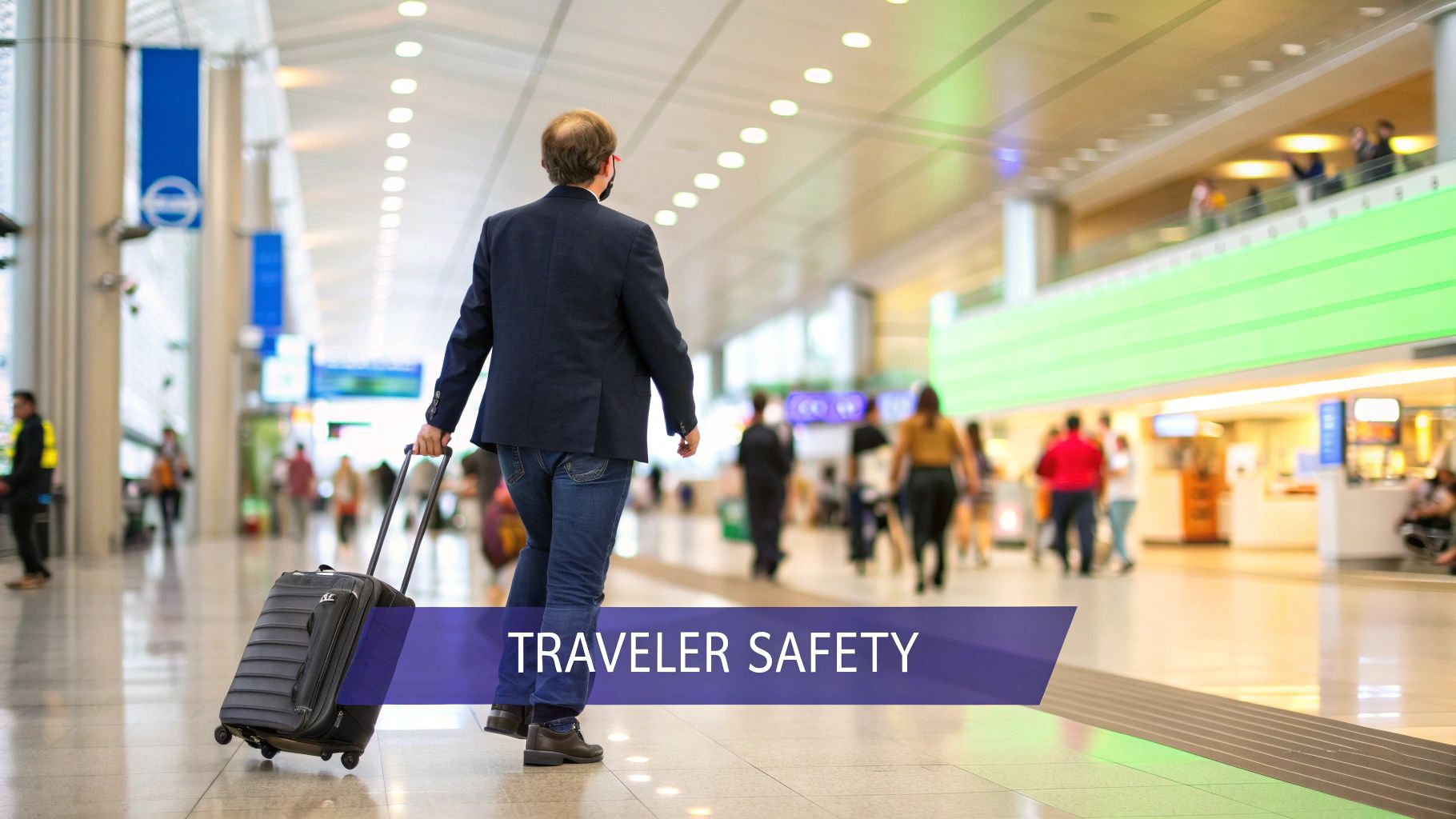
Building an Emergency Response Plan
When something goes wrong abroad, a clear, simple plan is everything. Your policy needs to spell out exactly what an employee should do and who to call. This isn't information that should be buried in a long document—make it accessible. A mobile app or even a printable, wallet-sized card works perfectly.
Your emergency plan must include:
- A 24/7 emergency contact number: This could be an in-house team or a dedicated third-party travel assistance provider.
- Local emergency service numbers: Make sure police, fire, and ambulance numbers for the destination are listed.
- Key company contacts: Include direct lines for the employee's manager and someone in HR.
This section is also where you clarify what the company provides. Do you offer comprehensive travel insurance? What does it cover—medical emergencies, lost luggage, trip cancellations? Be crystal clear about the coverage and how an employee actually uses it.
International Travel and Documentation
For trips overseas, getting the right travel authorizations is a non-negotiable part of your duty of care. Imagine an employee landing in the UK or Canada only to be hassled, delayed, or even denied entry because of a documentation issue. That’s a massive failure on the company's part.
Your policy shouldn’t just suggest getting the right documents; it should require that all necessary travel authorizations are sorted out long before departure. This includes visas and, increasingly, Electronic Travel Authorizations (ETAs).
Take the UK ETA, for example. It’s now a requirement for many visa-exempt travelers. While the application might look simple, small mistakes can easily lead to a rejection. To avoid this headache, you might even mandate the use of a trusted service to handle it.
To simplify the UK ETA application and boost the chances of approval, a service like AssistEntry is a smart move. Their experts walk you through the entire process, starting from just $79. More importantly, their team performs a full verification and compliance review before anything gets submitted. This massively increases the odds of approval and makes sure your travelers are ready to go. It’s a small investment that prevents huge logistical and personal crises, making it a crucial part of a robust duty of care protocol.
Balancing Cost Control with Traveler Flexibility
A rigid, one-size-fits-all corporate travel policy is a recipe for disaster. Let's be honest, the real art is in crafting a policy that saves money without chaining your travelers to rules that tank their productivity and comfort.
If your policy is too strict, people will just find ways around it. If it's too loose, you might as well be lighting your budget on fire. Finding that sweet spot is everything.
This means you have to move beyond a single set of rules for the entire company. The expectations for a quick domestic hop are completely different from a grueling long-haul international flight, and your policy needs to reflect that reality.
Segmenting Your Policy for Smarter Spending
A fantastic way to build that much-needed flexibility into your policy is to create different guidelines for different situations. Think of it as a tiered approach. It lets you tighten the belt where it makes sense while giving travelers the comfort they need on more demanding trips.
Here are a few common ways to segment your policy:
- Domestic vs. International Travel: International trips are a different beast. They often come with long flights, serious jet lag, and higher stakes. Allowing a premium economy seat on a flight over eight hours or bumping up the hotel budget isn't just a perk—it's an investment in making sure your employee lands ready to perform.
- Employee Level: It's pretty standard practice to set different rules for executives versus junior staff. Senior leaders who are constantly on the road or meeting with high-value clients might get more leeway in their booking choices, while entry-level folks can stick to more standard guidelines.
- Trip Duration: A quick overnight trip has totally different needs than a week-long conference. Your policy can easily specify different meal allowances or hotel standards based on ahow long someone will be away.
The best travel policies don't just bark rules at people; they guide employees toward making smart, cost-conscious decisions on their own. Flexibility within a clear framework encourages responsible spending far better than a long list of rigid don'ts.
Getting Specific with Flight and Hotel Rules
Setting clear but reasonable limits on flights and hotels is where you'll see the biggest wins for your budget. Instead of a blanket "economy only" rule, define the specific conditions where an upgrade is okay. It shows you trust your team's judgment while still keeping a lid on costs.
For instance, your policy might state that business class is approved for any international flight over 10 hours. Or maybe it's allowed when an employee has to go straight from the airport to a critical client meeting.
The same logic applies to hotels. Forcing everyone into the cheapest available option can seriously backfire. What if it puts your employee in an unsafe neighborhood or miles away from their meetings, racking up extra transportation costs and wasted time?
A much better approach is to set a price cap based on the city's average hotel rate or, even better, provide a list of preferred, pre-vetted hotels. This ensures safety and convenience while keeping expenses under control.
This kind of dynamic approach is becoming more critical as companies look to get smarter with their travel spend. Recent analysis shows a pretty cautious trend, with one in five large companies expecting to cut their travel budgets in 2025. This climate demands sharp, nuanced policies that optimize every dollar while still looking out for your travelers. You can dive deeper into these evolving corporate travel trends to get ahead of the curve.
Weaving in Sustainability and Modern Travel Realities
A great corporate travel policy does more than just keep costs in check—it mirrors your company’s values and adapts to how people actually travel today.
Modern priorities like sustainability and the rise of "bleisure" (blending business with leisure) are no longer just nice-to-haves. They’re essential. Getting this right not only boosts your brand's reputation but also makes your company a much more attractive place to work.
This means moving beyond just booking the cheapest flight. You need to actively encourage eco-friendly choices. For instance, your policy could promote rail travel for shorter trips or even incentivize employees to choose hotels with certified green initiatives. A great first step is to explore strategies for reducing corporate travel through video calls where it makes sense.

Tackling the Rise of Bleisure Travel
The line between work and personal life has blurred, making "bleisure" a firm reality. It's common for employees to add a few vacation days onto a business trip, but this can create a lot of confusion if your policy isn't crystal clear.
Your travel policy needs to have specific guidelines for these situations.
A fair and straightforward approach is to state that the company will cover the round-trip flight cost as it would have been for the business-only portion of the trip. Any extra costs from changing flight dates for personal time fall on the employee.
Key Takeaway: Be explicit about financial responsibilities for bleisure trips. Clearly state that costs for accommodation, meals, and transport during personal days are the employee's responsibility. This prevents misunderstandings and keeps everything fair.
This clarity protects everyone involved and makes it a win-win.
Weaving Sustainability into Your Policy
Sustainability has become a major focus for companies everywhere. It's no surprise that 46% of travel programs plan to prioritize eco-friendly practices in 2025. This involves embedding green initiatives and emissions data right into the booking process, showing a real commitment to traveling responsibly.
For international travel, modern travel management also means staying on top of entry requirements. If your American employees are heading to the UK, for example, they’ll need a UK ETA. Getting this wrong can cause travel disruptions, which has its own environmental and financial costs.
To get a clear understanding of the rules, our guide answers the question, do American citizens need a visa for UK travel? This way, your sustainable travel goals aren’t derailed by simple compliance issues.
Getting Your Travel Policy Off the Ground and Into Action
Let's be honest—a brilliant travel policy is just a document until your team actually uses it. If it's just sitting in a shared drive collecting digital dust, it’s not doing its job. The final and most critical piece of the puzzle is bringing it to life through smart communication and consistent enforcement.
Your rollout can make or break its success. Instead of just attaching a dense PDF to a company-wide email, think about how people actually absorb information. Create a simple one-page infographic that hits the highlights. Maybe a quick-reference guide for booking flights and hotels? The goal is to make the key takeaways impossible to miss.
Create a Culture of Understanding, Not Just Compliance
Real buy-in comes from understanding, not just blind obedience. You have to explain the why behind the rules. When your team sees that the guidelines are there to keep them safe, ensure fairness, and manage costs so the whole company benefits, they're far more likely to get on board.
Frame the policy as a tool designed to support them on their travels, not to restrict them. This simple shift in perspective fosters a culture of cooperation rather than one that feels like a top-down mandate.
Weave the Policy Directly Into Your Workflow
The best way to guarantee compliance is to make it the path of least resistance. This means building your policy rules directly into the tools your team already uses every day.
Modern booking platforms can be set up to flag or even block out-of-policy choices in real-time. This gives your travelers instant feedback while they’re booking, preventing mistakes before they happen and saving everyone from awkward conversations down the line.
For example, the system can automatically highlight preferred hotels or pop up an alert if a flight is over the budget for that specific route. This immediate feedback is so much more effective than a manual review after the fact. It also helps manage necessary paperwork; for instance, you'll need clear digital copies of documents for international trips. For a great walkthrough on this, our article on how to scan a passport provides clear, step-by-step instructions.
By building the policy directly into your booking tools, you make the right choice the easiest choice. The focus shifts from policing expenses to empowering employees to book correctly from the very start.
This proactive approach doesn't just cut down on non-compliant spending; it saves managers countless hours on approvals and corrections. It turns your policy from a static document into a dynamic, helpful guide that actively supports your team.
For international trips to the UK or Canada, a critical part of your policy is ensuring your team has the right travel authorization. A tiny mistake on a UK ETA or Canada eTA application can mean being denied entry, derailing an important business trip.
AssistEntry, a third-party application assistance provider, takes the guesswork and stress out of this process. Their experts meticulously review every detail of an application, catching errors and ensuring everything is compliant to significantly boost the chances of approval. With prices starting from just $79 (all-inclusive of government fees), it’s a small investment to prevent major travel headaches.
- To secure a UK ETA, visit AssistEntry's UK ETA page.
- For travel to Canada, use AssistEntry’s Canada eTA page.
